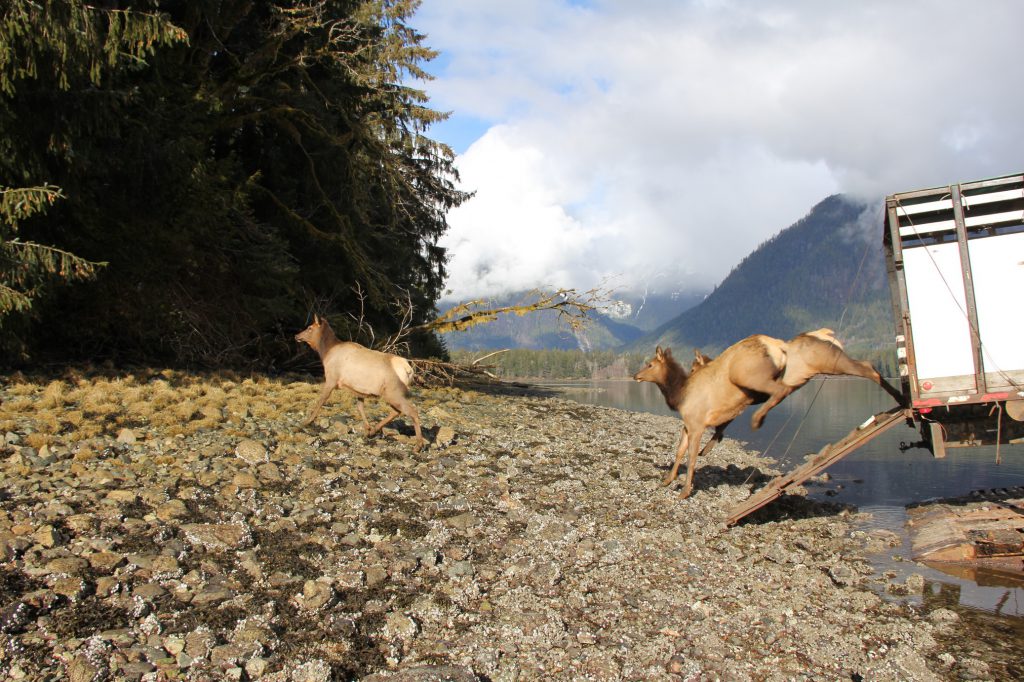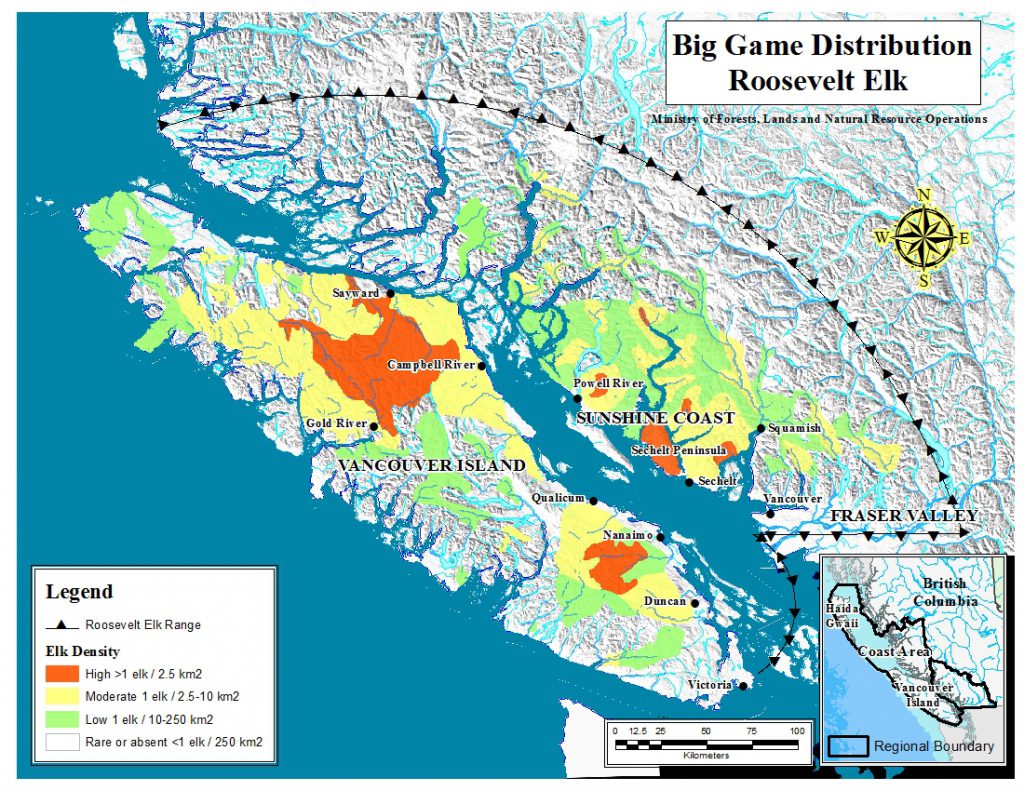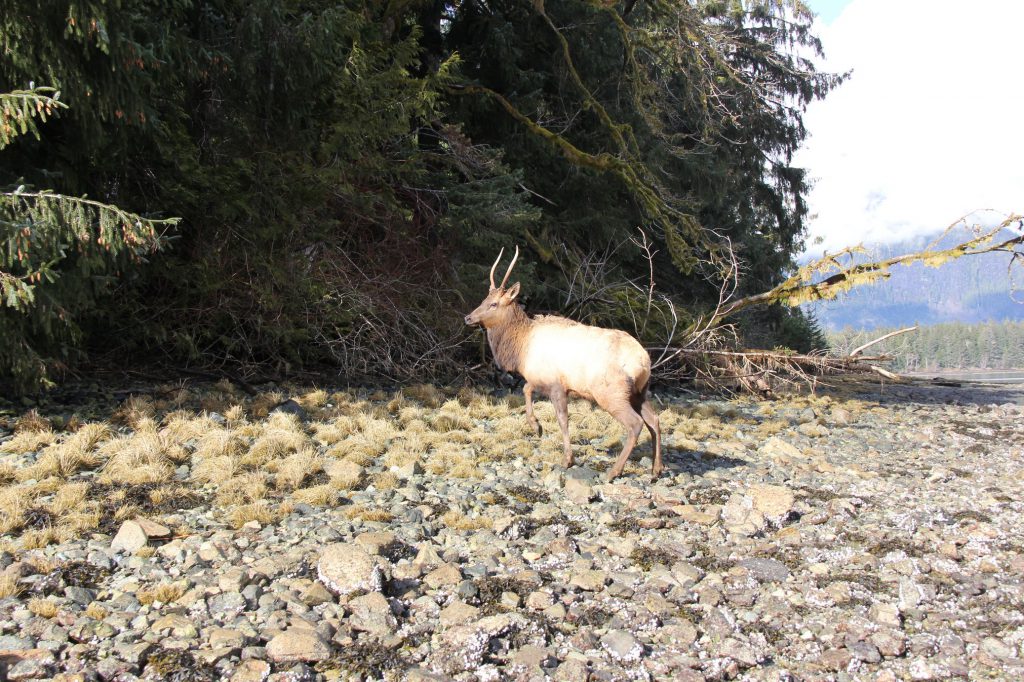 Wildlife and highways in BC often cross paths. We do our best to keep both everyone safe and sound on their journey, and our work with Roosevelt Elk on Vancouver Island and on the Sunshine Coast of BC is no exception.
Wildlife and highways in BC often cross paths. We do our best to keep both everyone safe and sound on their journey, and our work with Roosevelt Elk on Vancouver Island and on the Sunshine Coast of BC is no exception.
Did you know the majestic Roosevelt Elk could once be found roaming around what is now Science World along the shores of False Creek in downtown Vancouver? Sadly, unregulated hunting for meat and hides during the gold rush of the mid-1800s contributed to the local extinction of these elk in the southern portion of their BC range and a large part of their historic range is now occupied by humans.
Happily, provincial biologists have been capturing groups of nuisance elk from healthy populations and relocating them to suitable areas throughout southwest British Columbia. How do they do it? They focus on herds coming too close to active farms and along the highways. In addition to reducing the risk of wildlife deaths, this also helps reduce the wildlife hazard to travellers on roads frequented by elk.
That’s where we come in to the picture. Thanks to the Environmental Enhancement Fund, we are able to work alongside a host of other agencies and organizations to track the movement of elk and then capture and transport the animals to other locations. This year a group of fifteen elk (8 females, 5 calves, and 2 males) were successfully captured from an area beside a Highway 19A north of Campbell River. They were transported first by road and then over water to be released at priority sites on the mainland coast.

A Brief History of Roosevelt Elk Translocation in BC
Beginning on Vancouver Island in 1978, translocation became a core elk management tool almost immediately. Since 1978, there have been more than 30 projects undertaken on the Island. The first translocation from Vancouver Island to the Sunshine Coast was back in 1987. There have been a few other moves between the island and the Sunshine Coast since then, but the vast majority of efforts now happen within a region as opposed to between them.
The first translocation within the Sunshine Coast occurred in 1996. Since about 2000, captures have been happening annually on the Sunshine Coast, moving elk within the South Coast Region. More than 850 elk have been relocated in the Coast Area since 1978, with approximately two thirds of these elk moved around the South Coast Region since 2000. Yipee!

This type of translocation is key to the recovery of Roosevelt Elk, they help improve how the ecosystem works and provide future opportunities for recreational and food uses. Although their global distribution is smaller and more fragmented than it was pre-1900, we can happily say that the BC population is growing, especially where trans-locations have re-established Roosevelt Elk through their historic range.
All Hands on Deck
This project is definitely a group effort, requiring many helping hands to make it happen. To do it, we partner closely with community organizations, stakeholders and many others including:
- Ministry of Forests, Lands, Natural Resource Operations and Rural Development
- Ministry of Environment
- Habitat Conservation Trust Foundation
- First Nations in both the capture and release locations
- Forest Enhancement Society of British Columbia
- BC Wildlife Federation
- Campbell River Fish and Wildlife Association
- Sayward Fish and Game Club
- Gold River Rod and Gun Club
- Courtenay Fish and Game Association
- Don Hughes Trucking
- Buttle Shuttle
- Wildlife Stewardship Council
- City of Campbell River
How’s that for a comeback story? It sure makes us happy to keep wildlife and travellers safe in this way. Do you have any feedback or input on this or anything else we do here in the BC Ministry of Transportation and Infrastructure? Let us know in the comments below.
We have anywhere between 17 and 36 elk destroying fences, damaging fields, undermining tree root systems, bark removal, eating and or trampling saplings and seedlings. In addition, this many animals grazing regularly on the fields during growing season most definitely impacts our hay crops.
What criteria is used to determine when a herd has done enough damage and needs to be relocated?
Are there any programs available that would permit the animals to be legitimately and humanely farmed?
Thank you for any assistance you can provide.
Regards, Rob
Hello Rob,
Thanks for connecting with us. Here is a link to a contacts page for the Agriculture Wildlife Program.
https://www2.gov.bc.ca/gov/content/industry/agriculture-seafood/programs/agriculture-insurance-and-income-protection-programs/crop-loss-damage-due-to-wildlife
Hello , what similar projects will you have in near future and how can i get involved?
Hi there drk – thanks for your interest in this program. This project is definitely a group effort, requiring many helping hands to make it happen. To do it, we partner closely with community organizations, stakeholders and many others including:
Ministry of Forests, Lands, Natural Resource Operations and Rural Development
Ministry of Environment
Habitat Conservation Trust Foundation
First Nations in both the capture and release locations
Forest Enhancement Society of British Columbia
BC Wildlife Federation
Campbell River Fish and Wildlife Association
Sayward Fish and Game Club
Gold River Rod and Gun Club
Courtenay Fish and Game Association
Don Hughes Trucking
Buttle Shuttle
Wildlife Stewardship Council
City of Campbell River
We encourage you to reach out to tbe Ministry of Forests, Lands, Natural Resource Operations and Rural Development and The Ministry of Environment to speak to someone further about volunteer opportunities.
https://www2.gov.bc.ca/gov/content/governments/organizational-structure/ministries-organizations/ministries/forests-lands-natural-resource-operations-and-rural-development
https://www2.gov.bc.ca/gov/content/governments/organizational-structure/ministries-organizations/ministries/environment-climate-change
I love when humans think they know better than mother nature. If you introduce a species without predators or adequate means to control the population, then all you’ve done is introduced an invasive species. The mindset that these animals with stay in the forest when there is a plentiful easy field to eat in is ludicrous. Also this notion that the elk are being removed from areas where they impact agriculture is total BS, in 15 years not one has been removed from our farm. With populations growing I would think that protecting food security and the people that produce it would be massively important. Farmers have been really let down by this initiative.
Hi Ed – thanks for your comment. We have shared your concerns forward with our staff responsible.
If your trying to establish historic numbers of elk in areas there should be historic numbers of people .
Hi there Shelley,
Thanks for sharing your opinion with us here. You are right – the world has changed since those original historic numbers of elk were recorded and our human population has increased exponentially in that time as well. This exponential increase in people (and the land required to house and feed those people) makes it all the more important to secure habitat for these impacted animals. Helping them access safe areas to range freely, will help secure their herd into the future. Thanks again and safe travels.
Hi Shelly
Thanks for your comment. We encourage you to follow up with the program contact at the link below:
Agriculture Wildlife Program
https://www2.gov.bc.ca/gov/content/industry/agriculture-seafood/programs/agriculture-insurance-and-income-protection-programs/crop-loss-damage-due-to-wildlife
Have you secured habitat for these impacted animals yet? Because I’d like them off my farm .
Hi Shelly
Thanks for your follow up message. We work on this initiative as a partner and encourage you to reach out the program contact at the link below to discuss your specific issue:
Agriculture Wildlife Program
https://www2.gov.bc.ca/gov/content/industry/agriculture-seafood/programs/agriculture-insurance-and-income-protection-programs/crop-loss-damage-due-to-wildlife
And now they need to be culled. They are relocating into small towns like Youbou and lake Cowichan, tearing up yards and becoming a hazard on the hyways…..bloody stupid idea to trans locate them. Just don’t bring in wolves
Translocation involves removing elk from areas where they present a highway hazard and conflict with agriculture. The example in this blog includes capturing elk near Campbell River and moving to areas on the mainland.
What was the very first year that the Limited Entry Hunt for Island Roosevelt Elk started
Hi there Steve – the Ministry of Environment would be the best place to ask that question. Here’s their contact information:
We are also including a study report by the Ministry of Environment here for your reference: https://www2.gov.bc.ca/gov/content/environment/plants-animals-ecosystems/species-ecosystems-at-risk
http://www.env.gov.bc.ca/fw/wildlife/management-issues/docs/roosevelt_elk_management_plan.pdf
Did you find the answer to your question? I’m also curious as to when the first ele draws took place on the island.
In hopes of writing my first fiction piece for youth over 12, I want to know if ever a black bear, a grey wolf, and a Roosevelt elk could get along in a patch of the Mid-Coast(Smith Inlet to be exact)? My thesis is that my character befriends all over a period of time, so that they visit, relax, and play around his cabin. Then in an extraordinary cross-species move they save him from a natural disaster. That salvation depends on all three cooperating with rare intuition and intelligence.
Hi Ron, Wolves are predators and hooved animals, are their preferred prey. This includes elk, deer, bison, moose, domestic cattle, muskoxen and caribou. Even a single wolf can hunt these successfully. They are also known to eat young bears. (Source: http://www.whatdowolveseat.info/). From http://www.whatdobearseat.info/: “Black bears sometimes catch baby deer, cows and moose, but they are more likely to try to steal carcasses from more active predators like wolves, coyotes and cougars. Grizzly bears, like black bears, eat a lot of vegetation, but they also eat more meat than their cousins. Grizzly bears hunt deer, elk, moose and bison regularly, along with fish like salmon and trout.” From http://www.whatdopolarbearseat.info/: Polar Bears hunt for marine mammals like seals, and also eat trapped whales or whale carcasses. Reindeer, eggs, birds and Arctic foxes can also be part of their diet.
Hey Ron. If you were to have a bit of knowledge, you’d know that black bears and wolves are predators. Black bears prey on elk calves in the spring and wolves eat elk. No, they are not friends. Use your brain. Your thesis sounds like you put no thought into it. Any kid that reads your story is going to be another uneducated individual believing in a bambi-like fairytale. Anyways, no – an elk, wolf, and bear are not friends, it’s real life.
Well Henry every time I see blacks bears near elk calves they are up a tree being circled by stomping cows! Black bears eating elk, only after pickup runs them over
Why are these animals really being relocated? Looks like a lot of partnerships with Gun Clubs. Is this all about hunting them?
Hi David,
While sustenance and recreational uses are a recognized benefit of the successful re-establishment of Roosevelt Elk in coastal areas – the primary goal of the program is to re-establish Roosevelt Elk into remote and under-utilized watershed habitats.
Their presence in these areas provides a significant benefit to the function of these ecosystems.
As generalist herbivores, Roosevelt Elk browse and graze a wide variety of plant species and as the largest subspecies of elk in North America, they can affect the plant phenology and succession in the ecosystems they are a part of. Throughout their range on Vancouver Island, Roosevelt elk are the largest prey species available to apex predators such as wolves and cougars. (There is also anecdotal evidence that black bears prey on elk calves on Vancouver Island.)
Although their global distribution is smaller and more fragmented than pre-1900, the BC population is growing, particularly where translocations have re-established the elk through their historic range. While natural dispersal of Roosevelt Elk to new watersheds is slow to occur, translocation of elk has proven effective in re-establishing populations into remote watersheds. With translocation of herds into underutilized habitats, the benefits to the ecosystem function and from the uses of this species can be appreciated earlier than would be otherwise possible.
Roosevelt Elk are on the Provincial Blue-list and are subject to conservative Limited Entry Hunting (LEH) and harvest by First Nations in the Coast Area. Hunters submit approximately 16,000 applications annually for approximately 200 Roosevelt Elk LEH opportunities on Vancouver Island and First Nation hunters harvest as many elk through harvest arrangements between governments. These uses generate direct revenue to the Province, the Habitat Conservation Trust Fund, as well as tourism benefits to small businesses in many local communities.
Thanks for your comment – we hope that this helps answer your question.
Dear Editor,
Congratulations on the success of your Roosevelt Elk Reintroduction program.
Can you provide any information on the Elk in the Fraser Canyon?
I see the roadside warning signs when transiting the Canyon, but have not yet
seen any elk. Perhaps that is a good thing, given the number of live and road
killed deer I see. I appreciate the warning signs; an Elk coming through the
windshield could really take the glow off the day!
Also, can you provide any information on the reintroduction of Caribou to the
Cariboo/Chilcotin Region, where they were reportedly indigenous prior to the
moose invasion?
Thanks and Happy Trails.
Ramblin’ Ryan Lake
Clinton, B.C.
Hello Ramblin’ Ryan and thanks for your email! We have sent your questions forward to the lead ministry on this initiative – Ministry of Forests, Lands and Natural Resource Development. They should have an answer to your questions. Stay tuned!
Hello again Ramblin’ Ryan,
Our apologies for the delay in tracking down more information for you. Those wildlife biologists spend a lot of time out in the field!
Here’s what we heard: Elk sightings in the Frazer River Canyon (Hope to Boston Bar area) are rare and we don’t believe there are any elk crossings signs along this stretch of Highway 1. There is a historic small population of elk near Lytton. You might try to direct your inquiries about this population to the Fish and Wildlife branch out of Kamloops. The general inbox for this group is: FishandWildlife@gov.bc.ca
We hope that this helps some. Thanks again for connecting with us here.